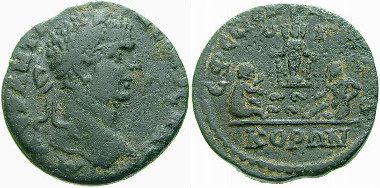Documenting the Past: an Ancient Industry recorded in Coinage
by Claire Franklin
An unusual coin type recently sold at auction depicts an ancient industry, hitherto unrecorded on coinage or sculptural reliefs: the production of noodles. The coin, which fetched 30,000 GBP at the London-based Ceres Auction House, was minted at Ephesus in the reign of the Roman emperor Geta (209-212) and depicts two figures using an ancient form of noodle machine.
Two workers collect ‘Spätzle’ from a noodle machine in the form of Artemis Chondriates with her well known strings of dumplings. Ceres, Auction 14 (2015), Lot No. 117.
As clearly depicted on the coin, one figure feeds the device, which is shaped like a goddess, with dough while the other lays the finished product out to dry (although a recent theory put forth by Dr. Brett Teigleman of the University of Lower Minnesota has proposed the theory that the figure on the right is scraping spätzle from a board by hand, just as is done today in Southern Germany, Switzerland and Austria). We can see that the dough is forced out of the machine at high pressure in regularly shaped portions.
Although it is commonly held that noodles originated in China before being brought to Italy by Marco Polo, they were in fact widely enjoyed throughout the ancient world: the geographer Strabo and Pliny the Elder describe the production of alicia or chondroi from spelt in Campania (Natural History 18.8), although the earliest reference to chondroi occurs in an unfortunately largely unintelligible fragment of Aristophanes’ comedy Mageiroi, “The Cooks”, from 414 B.C. (Kock, Frag. 496b). This coin suggests that the production of spätzle was widespread in the grain-rich districts of Ionia, and epigraphic evidence also records the presence of guilds of ‘Hypochondroi’ or artisan noodle-makers there and their worship of Artemis Chondriates, to whom they offered sacred dough products (IG 2.II,40 (Ionia), 570-572b, ll. 2,8).
At a time when the pedigree of a coin is so important, this coin can boast an impeccable lineage. The theme of noodle-making on coins, as described at length by Goltzius (1582) and other early authorities, attracted the attention of the amateur numismatist and “Father of Swabian Cookery”, Magister Hartmut Klötzle, who bought the coin from the travelling dealer Claudio Constantini at around the time that he met his wife Maria Emilia Garrella (-Klötzle), heiress of the well-known Garrella pasta company, at the Milan Trade and Commerce Fair of 1892. The coin formed a prized part of their collection, most of which was dispersed in order to fund a new factory kitchen in the 1980’s. This piece remained in the possession of the Garrella-Klötzle family until the present auction sale. In a curious twist of fate, the coin is believed to have been bought by the billionaire director of the Beijing Dumpling Company, Ma Xi Peng.









